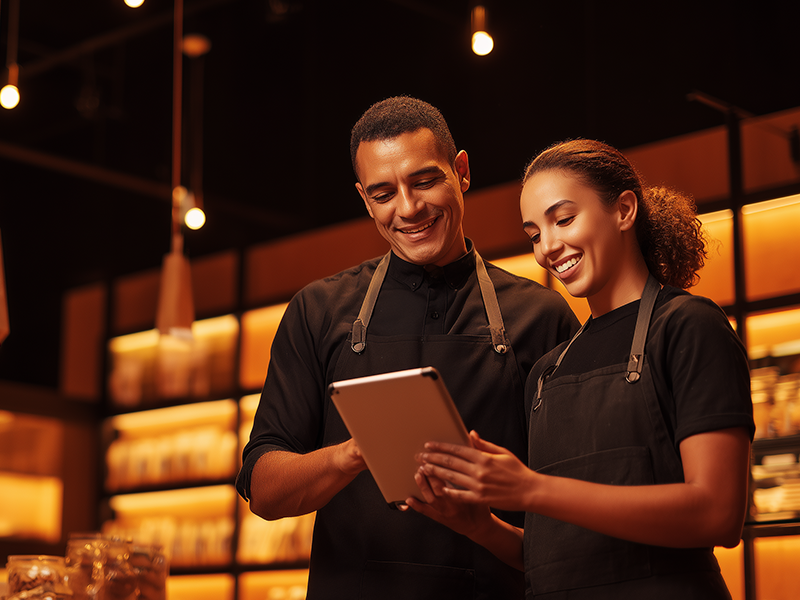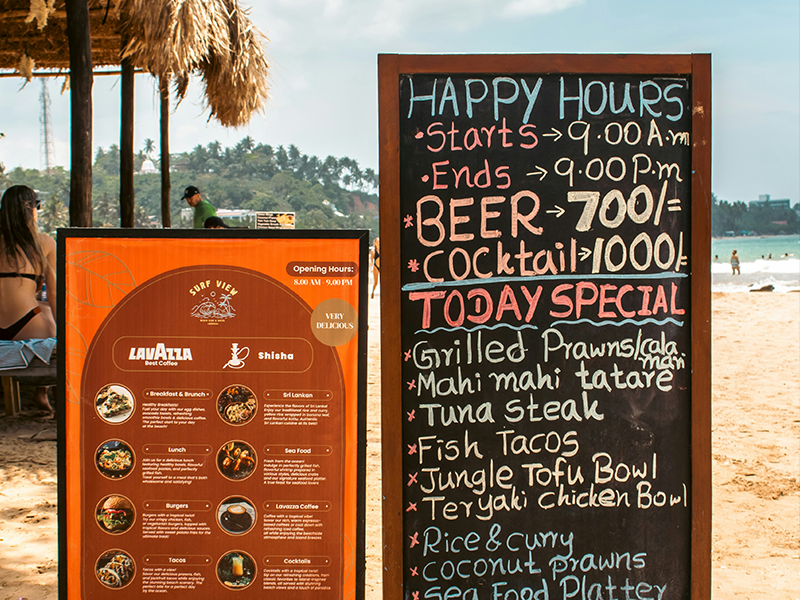By Katrin Krakovich, CEO & SEO Expert at Lahav Media
Let me guess. You're staring at empty tables during what should be your lunch rush, wondering why the Italian place down the street is packed while you're serving maybe twelve customers on a Tuesday. You've tried posting pretty food photos on Instagram, maybe even threw some money at Google Ads that disappeared faster than a free appetizer at happy hour.
Here's the truth: local restaurant promotion ideas that actually work aren't about following the latest TikTok trend or spending your entire marketing budget on Facebook ads. They're about understanding your neighborhood, connecting with your community, and showing up exactly where hungry people are looking for you.
After helping dozens of restaurants, cafes, and bars transform from ghost towns to neighborhood hotspots, I've learned that the most effective local restaurant promotion strategies combine old-school community building with smart digital tactics. And yes, they work whether you're running a cozy coffee shop, a family-owned Italian restaurant, or a craft cocktail bar.
Why Most Restaurant Promotions Fail (And How to Avoid These Mistakes)
Before we dive into what works, let's talk about what doesn't. I see the same mistakes every week when restaurant owners call me, frustrated and wondering why their marketing feels like throwing money into a black hole.
The biggest mistake? Treating promotion like a one-size-fits-all solution. That Instagram strategy working for the trendy brunch spot in Manhattan probably won't work for your neighborhood pub in Ohio. Your customers are different, your neighborhood is different, and your competition is definitely different.
Most restaurant owners also make the classic error of focusing only on new customers while ignoring the goldmine sitting in their existing customer base. Getting someone to try your restaurant once is expensive. Getting them to come back monthly? That's where the real money lives.

Community-Based Local Restaurant Promotion Ideas
Partner with Local Businesses for Cross-Promotion
This isn't about slapping each other's flyers on your counter. Real cross-promotion creates genuine value for customers while expanding your reach into established customer bases.
Try this: Team up with the yoga studio next door to offer a "Zen and Ziti" package. Customers get a discount at your restaurant after their evening class, and the yoga studio gets a commission for every referral. The bookstore across the street could promote a monthly "Dinner and Discussion" night where book club members get a special menu.
I've seen coffee shops partner with local gyms to offer post-workout smoothie discounts, and pizza places team up with movie theaters for "dinner and a show" packages. The key is finding businesses that serve your ideal customer when they're not eating.
Sponsor Local Events (The Smart Way)
Forget about being the "official hot dog sponsor" of every little league team in town. Strategic local event sponsorship means choosing events where your ideal customers actually spend time.
If you run a craft beer bar, sponsor the local art walk or music festival. If you're a family restaurant, consider sponsoring school fundraisers or community fun runs. The goal isn't maximum visibility; it's relevant visibility among people who will actually become regular customers.
One clever approach: Create your own event. Host a monthly trivia night, live music series, or cooking class. You control the experience, build direct relationships with customers, and create content for your social media without relying on someone else's event planning.
Build Relationships with Local Food Bloggers and Influencers
Before you roll your eyes, I'm not talking about chasing influencers with millions of followers who charge more than your monthly rent. I'm talking about the local food blogger with 3,000 engaged followers who actually live in your area.
These micro-influencers often have incredibly loyal audiences, and they're usually happy to try your restaurant in exchange for a great meal experience. Focus on bloggers and social media accounts that regularly feature local businesses and have audiences that match your customer demographics.
The secret sauce? Don't just invite them for a free meal and hope for the best. Create an experience worth talking about. Maybe it's a behind-the-scenes kitchen tour, a wine pairing dinner, or early access to your new seasonal menu.

Digital Marketing Strategies That Actually Work
Master Google Business Profile for Local Search
Here's something that might shock you: most restaurant owners treat their Google Business Profile like a digital business card when it should be their most powerful marketing tool.
Your Google Business Profile determines whether you show up when someone searches for "best pasta near me" or "coffee shops open now." It's not just about filling in your hours and uploading a few photos.
Post weekly updates about new menu items, special events, or seasonal offerings. Respond to every review (yes, even the bad ones) professionally and personally. Use Google Posts to announce daily specials or limited-time promotions. Upload fresh, high-quality photos regularly.
Most importantly, encourage happy customers to leave reviews, but do it naturally. Train your staff to mention it: "If you enjoyed your meal, we'd love to hear about it on Google." Don't incentivize reviews with discounts; Google can detect that and it actually hurts your rankings.
Email Marketing for Restaurants (Beyond Basic Newsletters)
Email marketing for restaurants isn't about sending weekly newsletters that nobody opens. It's about creating a direct line of communication with your best customers and giving them reasons to come back more often.
Segment your email list based on customer behavior. Send different messages to your weekend brunch crowd versus your Thursday happy hour regulars. Your frequent customers might appreciate early access to new menu items, while occasional visitors might need a gentle reminder about your existence.
Try location-based email campaigns. When it's raining, send a "cozy indoor dining" message. When there's a big game, promote your sports viewing experience. When it's beautiful weather, highlight your patio seating.
Social Media That Actually Drives Traffic
Social media for restaurants shouldn't be about posting pretty food photos and hoping for likes. It should be about driving specific actions: reservations, takeout orders, event attendance.
Instead of just posting a photo of your signature dish, tell the story behind it. Share the inspiration, the sourcing, the technique. People eat with their eyes first, but they return for the experience and connection.
Use Instagram Stories and Facebook Stories for time-sensitive promotions. "We have three tables available for tonight" or "fresh lobster just arrived, available while supplies last." These create urgency without feeling pushy.
Optimize for Voice Search and AI Search Results
This might sound technical, but it's simpler than you think. When people ask Siri "where should I get dinner tonight?" or ChatGPT "best coffee shops near me," you want your restaurant to be mentioned.
Write your website content and Google Business Profile descriptions in natural, conversational language. Instead of "We serve authentic Italian cuisine," try "We make fresh pasta daily using recipes passed down from our owner's grandmother in Naples."
Answer the questions people actually ask. Create content around "What's the best restaurant for a first date in [your city]?" or "Where can I get great coffee and work on my laptop?" If you answer these questions better than your competition, AI search tools will find and recommend your business.
Seasonal and Event-Based Promotion Ideas
Holiday and Seasonal Promotions That Feel Fresh
Everyone does Valentine's Day dinner specials and Mother's Day brunch. The restaurants that stand out are the ones that find unique angles or create their own seasonal moments.
Instead of a basic Valentine's dinner, what about a "Galentine's" lunch for friend groups? Instead of standard Christmas catering, what about "Christmas Eve Survival Kits" with heat-and-serve family dinners for stressed parents?
Create your own food holidays. "Taco Tuesday" is taken, but what about "Wine Down Wednesday" or "Freaky Friday" with experimental menu items? The key is consistency; if you create a weekly or monthly special, stick with it long enough to build anticipation.
Community Event Tie-Ins
Pay attention to your local calendar beyond the obvious holidays. When's the farmer's market? High school graduation season? Local festival weekends? College move-in day?
Create promotions that serve the specific needs of these moments. Graduation party catering packages. Festival weekend breakfast specials for out-of-town visitors. Late-night options during local concert series.
The coffee shop that opens early during the annual charity 5K, the pizza place that offers pre-game specials during football season, the cafe that creates "study fuel" packages during finals week. These businesses understand their community rhythms and position themselves as essential parts of local life.
Budget-Friendly Promotional Tactics
Loyalty Programs That Actually Work
Forget complex point systems that require customers to do math to figure out their rewards. The best loyalty programs are simple, immediate, and relevant to how people actually visit your restaurant.
A punch card that gives every 10th coffee free works because it's simple and the reward timeline makes sense for regular coffee drinkers. A "VIP text club" that sends exclusive deals works because it feels special and the deals arrive when people are deciding what to eat.
Consider frequency-based rewards rather than spend-based ones. "Come in three times this month and get a free appetizer" encourages regular visits from all customers, not just big spenders.
Referral Programs and Word-of-Mouth Marketing
The best restaurant marketing is still word-of-mouth, but you can systematically encourage it. Create experiences and moments that people naturally want to share.
Maybe it's the way you present certain dishes, your unique greeting style, or a signature element that makes people say "you have to try this place." One restaurant I know serves their famous cookies in a tiny paper bag with a sticker, and customers constantly post photos of the adorable packaging.
Implement a simple referral program: "Bring a friend who's never been here, and you both get 15% off." It's simple, trackable, and creates positive experiences for both existing and new customers.
Strategic Partnerships with Delivery Apps
Love them or hate them, delivery apps are part of the restaurant ecosystem. But you don't have to let them eat your profits.
Use delivery apps strategically for customer acquisition, not just order fulfillment. Create delivery-exclusive menu items with higher margins. Offer "first-time customer" deals through the apps to attract new customers, then encourage them to order directly next time.
Consider offering slightly lower prices for direct orders or pickup orders. A simple "10% off when you order directly" message on your delivery packaging can gradually shift customers to more profitable ordering channels.
Measuring Success and ROI

Track the Right Metrics
Most restaurant owners track the wrong things. Total social media followers doesn't matter if they're not local customers. Website traffic doesn't matter if it's not converting to reservations or orders.
Focus on metrics that connect directly to revenue: repeat customer rate, average customer lifetime value, cost per new customer acquisition, and most importantly, which marketing activities actually drive customers through your door.
Use simple tracking methods. Give different promo codes to different marketing channels. Ask new customers how they heard about you and actually record the answers. Track which Google Business Profile posts get the most engagement and lead to calls or visits.
A/B Testing for Restaurants
You don't need fancy software to test what works. Try two different email subject lines and see which gets better open rates. Test two different social media post styles and track which drives more engagement. Offer the same promotion through different channels and see which performs better.
The key is changing only one thing at a time so you can identify what actually makes the difference. Restaurant marketing is full of conventional wisdom that doesn't always apply to your specific situation and customer base.
Common Mistakes to Avoid
Over-Promotion and Discount Fatigue
If you're constantly offering 20% off, 30% off, BOGO deals, you're training customers to never pay full price. Worse, you're attracting deal-seekers who will disappear the moment you stop discounting.
Instead of constant discounts, focus on added value. Free appetizer with entree purchase. Complimentary dessert for anniversaries. Exclusive menu items for loyalty program members. These strategies reward customers without devaluing your regular pricing.
Ignoring Negative Feedback
Bad reviews happen. Negative comments appear. The wrong response is ignoring them or getting defensive. The right response is addressing them professionally and using them as opportunities to show potential customers how you handle problems.
A restaurant that responds thoughtfully to criticism often looks better than one with only positive reviews. People trust businesses that acknowledge imperfections and show how they improve.
Inconsistent Brand Messaging
Your Instagram shouldn't feel like it's run by a different business than your website or your actual restaurant experience. Consistency in tone, visual style, and messaging helps customers know what to expect and builds trust over time.
This doesn't mean everything has to be identical, but there should be a clear connection between your online presence and your physical space. If your social media is fun and casual, your restaurant should feel welcoming and relaxed. If your website emphasizes fine dining and attention to detail, that better match the actual experience.

-p-500.jpg)
